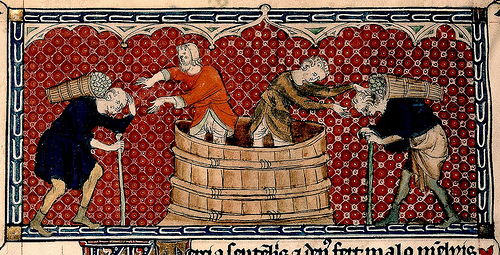
THIS FOURTEENTH CENTURY manuscript illumination shows just-picked grapes being hustled from the vineyard and dumped into vats where empurpled treaders are already frantically at work. It was customary for medieval artists to compress events that happened over time into a single frame – but I like to think that in this case they may have got it exactly right.
What’s the rush? Well, if you were a winemaker with property in Bordeaux around this time you had to do some hurrying if you were going to harvest, vinify, finish, and sell your vintage all in a matter of weeks. That’s when ships bearing the year’s new wine sailed from the port of Bordeaux in time to earn the highest prices of the year at the biggest selling opportunity of the year: Christmas at the Plantagenet court at Westminster.
The weeks-old red Bordeaux onboard wasn’t what we would called today a vin de garde, a wine for long keeping. It may have strained to achieve a 9 or 10 degrees of alcohol, and since long macerations were out of the question given the time constraints it could scarcely have taken on much color. Barely more deeply hued than a robust rosé, such wine was clairet in French – a name that would cling to red Bordeaux for centuries in the anglicized form of claret.
It wasn’t just winemakers who were in a hurry. Everyone in the medieval supply chain was eager to be in possession of wine for the shortest time possible and for a very good reason: it didn’t last. Low in alcohol and tannins and stored in barrels that were far from airtight, medieval wine was a fragile thing, ever in danger of going off. Whether winemaker, negociant, broker, blender, wholesaler, or retailer you were anxious to get paid and pass the goods (and the risk) on as soon as ever you could.
The same was true for the people we now like to call end-users. With bottle and cork technology still a few centuries in the future, innkeepers, caterers, proprietors of wineshops, and householders bought and stored their wine in cask, too. This meant that from the moment the barrel was tapped and wine was drawn off, oxygen would begin its nefarious work and your stock was at risk.
The few weeks sandwiched between the Yuletide and the onset of Lent in February may well have been the only time all year when a medieval European could be reasonably sure of enjoying a glass of fresh, sound wine. It makes one wonder whether all the hearty partying and socially-sanctioned inebriation we associate with the period shouldn’t be laid squarely at the feet of wine’s frightening propensity to go off. Sic transit gloria vini. Eat, drink and be merry for tomorrow your wine will good for nothing but dressing the salad.
The few weeks sandwiched between Yuletide and the onset of Lent in February may well have been the only time a medieval European could be reasonably sure of enjoying a glass of fresh, sound wine.
The logistics of the holiday market drove the Bordelais to some unforgivably low behavior. In early days, Bordeaux prospered by providing the port facilities through which wine from what was called the High Country upriver from the city (including Gaillac, Bergerac, Cahors) found an outlet. Later the Bordelais devised to plant their own vineyards and craft some distinctly discriminatory legislation that gave a leg up on the competition. Wines from the High Country now had to wait until after December 1 to make the journey downriver for shipment to English and German markets, assuming there was any market left by that late date. By then, the moment when top prices could be gotten was already past; buyers had spent their money and set sail.
These shamelessly self-serving laws were still in place several centuries later when a minister of Louis XVI complained that “The conduct of this set of rules is most artfully devised to guarantee the bourgeois of Bordeaux, owners of the local vineyards, the highest prices for their own wines, and to disadvantage the growers of all the southern provinces . . .” Bullied out of the market by the Bordelais, High Country wines never recovered the prestige they once enjoyed.
Today we needn’t be in such a blazing hurry about our wine, or so anxious for its well-being. Maybe Christmas 2012 is the right time to effect a reconciliation of sorts between these old antagonists. A little claret under the tree, a little High Country wine in the stocking . . .
Tasting Notes: Christmas wine from the French Southwest
Chateau d’Aiguilhe “Seigneurs D’Aiguilhe” Castillon Cotes de Bordeaux 2010. Medium garnet hue. Aromas of spicy red berry fruits and loam; palate is leanish and firm with more red fruits, earthy notes, and nicely firm acid structure. No evident oak. Shapely, brisk, some grip. $22
Chateau Senailhac Bordeaux Superieure 2006. Limpid medium garnet with some orange tints. Really firm, crisp – almost crunchy — high-toned red fruit with very convincing acidity. Quite austere at first, fruit sweetens up in the glass. Tannins are fine-grained and still a bit tight, though not assertive. Think skirt steak . . . beef short ribs . . . goose! $19.
Domaine Rotier “Les Gravels” Gaillac 2008. Medium ruby-black. Lovely, sweet black cherry-like fruit is wrapped in some cushy-chewy tannins that feel wonderful. Long, lightly mentholated finish. 40% Duras, 25% Braucol, 35% Syrah. $17.
Chateau Peyros Madiran 2007. Genuinely complex aromas show notes of cedar, raspberry preserves, eucalyptus, earth. The feel is lean and lightly astringent, with grippy, fine-grained tannins and lip-smacking acids. This is grown-up wine. 60% tannat; 40% cabernet franc. $20.
Reach me at stephenmeuse@icloud.com
Follow @stephen_meuse